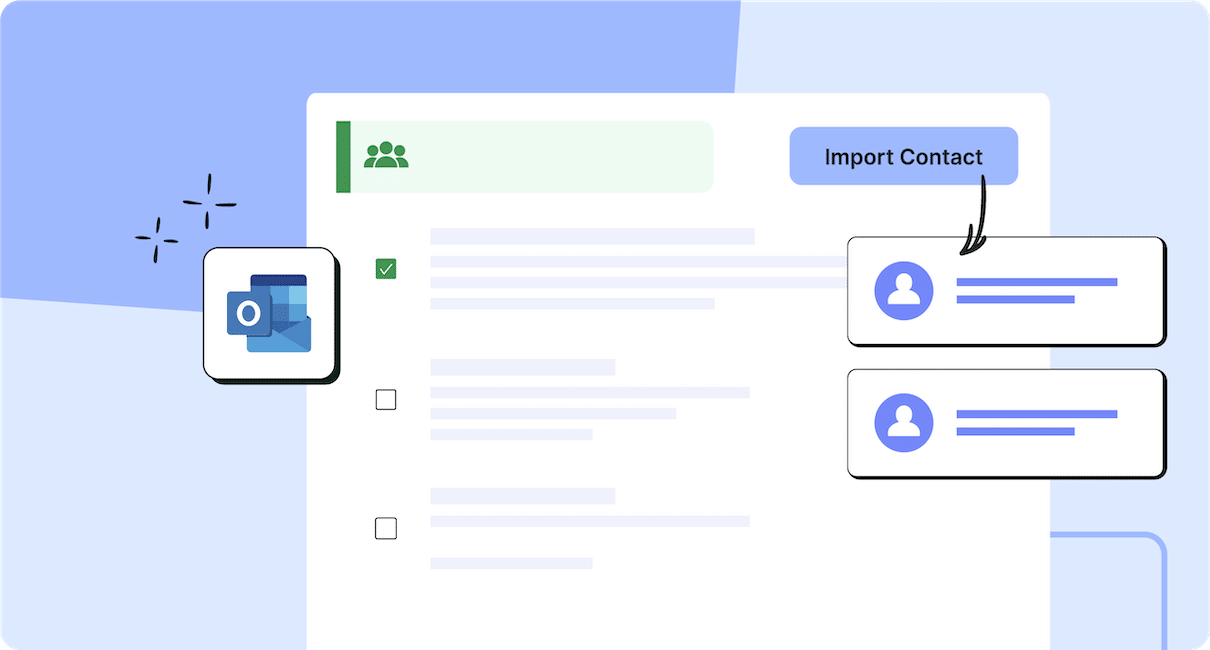“How should I collect employee feedback?” is a common question amongst communicators. With so many options to consider, we’ve broken down the top 10 ways to gather employee feedback with easy-to-follow use cases and examples.
Companies that focus on understanding how to gather employee feedback will discover high-impact insights. Consider employee feedback as a compass to guide your organization’s success. Regular workplace feedback also showcases the value of internal comms initiatives.
In this guide, we’ll explore 10 proven strategies for how to gather employee feedback, offering practical examples and tips. By the end of this article, you’ll have a better understanding of how to navigate challenges like getting anonymous employee feedback and ways to streamline the feedback process.
Revive employee engagement with targeted, interactive emails and newsletters
Book a 15 minute call with one of our team members
Why Collecting Employee Feedback is Important
Collecting employee feedback provides real-time insights into your team’s needs, challenges, and motivations. Getting employee feedback boosts trust, ensures alignment with organizational goals, and fosters a greater sense of ownership among employees.
Key benefits to collecting employee feedback:
- Improve employee engagement and retention.
- Uncover opportunities for process and culture improvement.
- Drive innovation through diverse perspectives.
Check out our blog on the importance of employee feedback for an in-depth look at the organizational benefits.
How to Effectively Collect Employee Feedback: 10 Key Strategies with Examples
Whether you’re navigating organizational change, addressing employee concerns, or striving to boost engagement, knowing how to collect employee feedback effectively is key for your IC practice. Let’s look at our top 10 strategies here:
1. Employee feedback surveys
Employee feedback surveys are foundational for gathering structured, quantifiable insights into workforce satisfaction, engagement, and productivity. They enable organizations to identify trends, pinpoint challenges, and implement targeted improvements. Understanding how to collect employee feedback through surveys provides a clear pathway to enhancing workplace culture and engagement.
Use cases:
- Annual satisfaction assessments: Gain a yearly overview of employee morale, role satisfaction, and workplace culture.
- Post-change feedback: Gather insights after implementing new policies, tools, or leadership changes.
Examples:
- After launching a new performance management system, distribute a survey to assess ease of use, adoption rates, and overall satisfaction.
- Following the rollout of flexible work policies, create a survey to measure employee satisfaction with the new arrangement and gather improvement suggestions.
Tips to execute:
- Be clear and concise: Ensure survey questions align with specific business objectives, making how to ask for employee feedback straightforward and meaningful.
- Leverage software: Use employee feedback software to automate survey creation and analyze responses efficiently.
- Analyze trends: Segment responses by department, tenure, or job role to identify actionable trends.
Considerations:
- Avoid fatigue: Limit surveys to essential topics to prevent employees from feeling overwhelmed.
- Ensure anonymity: Implement strategies for how to collect anonymous employee feedback to encourage honesty.
Pulse surveys that actually engage employees
Get instant feedback with our interactive survey tools—without switching platforms.
2. Pulse surveys
There are plenty of pulse survey benefits – you gain real-time insights, enable your organization to track workforce sentiment frequently, they’re quick and easy to deploy, and more (which we tell you about in our Benefits of Employee Pulse Surveys post). These short, targeted surveys help organizations understand how to gather employee feedback efficiently and act on trends before they escalate.
Use cases:
- Morale check: Gauge employee sentiment during challenging periods, such as organizational restructuring or after a major project deadline.
- Leadership feedback: Assess how new initiatives or management changes are perceived.
Examples:
- Send a weekly pulse survey asking, “How manageable was your workload this week?” to track stress levels and resource needs.
- After launching a company-wide diversity training, issue a short survey to measure its impact and gather suggestions for improvement.
Tips to execute:
- Keep them short: Limit surveys to 5–10 questions focused on key areas, ensuring participants feel their time is respected.
- Focus on actionability: Craft questions that directly address specific organizational needs or challenges.
- Leverage digital tools: Use a tool like ContactMonkey, to automate and streamline the process.
Considerations:
- Frequency balance: Avoid overwhelming employees with too many surveys by scheduling them strategically.
- Ensure anonymity: Incorporate techniques for how to get anonymous employee feedback to build trust and improve participation.
🎁BONUS: Need more detail on how to transform pulse survey results into opportunities for transformation? Read our article on How Pulse Survey Results and Data Analysis Deliver Insight.
3. One-on-one meetings
Direct, personal conversations provide an opportunity for managers to understand how to get feedback from employees in a nuanced and individualized manner. These meetings foster trust and encourage open dialogue. Below we address the common question of “How to ask for employee feedback?” effectively.
Use cases:
- Team dynamics: Managers can gather personalized feedback to improve collaboration.
- Development plans: Identify growth opportunities and discuss career trajectories.
Examples:
- Ask questions like, “What support do you need to achieve your goals, and how can I assist you in reaching them?”
- Use one-on-ones to address specific concerns raised in team surveys, ensuring employees feel their feedback is heard and valued.
Tips to execute:
- Prepare key questions: Come ready with focused prompts that show intent and care, such as “How do you solicit employee feedback?” about recent projects.
- Foster a safe environment: Cultivate an atmosphere of openness and mutual respect.
- Document findings: Take notes to track progress and follow up on key points.
Considerations:
- Time limitations: Scheduling frequent one-on-one meetings may be challenging in large teams, so prioritize based on needs.
- Tailor to individuals: Adapt your approach to suit different employee communication styles.
4. Focus groups
Focus groups allow organizations to explore how to gather employee feedback in a collaborative and dialog-driven setting. They provide qualitative insights that can reveal underlying trends and concerns.
Use cases:
- Brainstorming solutions: Address specific workplace issues collaboratively.
- Cultural insights: Understand employee perceptions of the company’s mission, values, and culture.
Examples:
- Conduct a session to explore onboarding experiences.
- Facilitate a group discussion on improving internal communication processes.
Tips to execute:
- Diverse participants: Select employees from various roles and departments to capture broad perspectives.
- Skilled facilitation: Use a trained facilitator to ensure balanced participation and inclusivity.
- Structure discussions: Begin with open-ended questions and progress to specific topics for actionable insights.
Considerations:
- Dominant voices: Prevent a few participants from overshadowing the discussion.
- Anonymize results: Present findings without attributing specific comments to encourage openness.
5. Suggestion boxes
Suggestion boxes, both physical and digital, remain a simple yet effective tool for understanding how to get anonymous employee feedback. They allow employees to share ideas, concerns, and solutions without fear of judgment.
Use cases:
- Improvement ideas: Collect suggestions for enhancing processes or workflows.
- Workplace pain points: Identify common frustrations or obstacles employees face.
Examples:
- Set up a digital suggestion box for remote teams to contribute ideas.
- Use physical boxes in common areas for on-site employees.
Tips to execute:
- Promote awareness: Regularly remind employees that the suggestion box is available for their input.
- Act on suggestions: Review submissions promptly and share updates on how feedback is being addressed.
Considerations:
- Transparency: Communicate clearly about the purpose of the suggestion box and how feedback will be used.
- Follow-through: Demonstrating action based on feedback is key to maintaining trust and engagement.
Free guide to genuine employee feedback in surveys
Will your people tell the truth? Here’s how to build trust.
6. Exit interviews
Exit interviews are invaluable for learning about why to collect employee feedback and how to use it to refine retention strategies. Departing employees often provide candid insights into organizational strengths and weaknesses.
Use cases:
- Team evaluation: Assess dynamics and workflows from an outsider’s perspective.
- Retention improvement: Identify common reasons employees choose to leave.
Examples:
- Ask departing employees, “What factors influenced your decision to leave?”
- Use feedback to identify patterns, such as dissatisfaction with leadership or lack of career growth.
Tips to execute:
- Neutral environment: Conduct interviews in a relaxed setting to encourage honesty.
- Standard templates: Use a consistent employee feedback template to compare data across interviews.
Considerations:
- Combine with surveys: Use exit feedback alongside broader employee engagement surveys for a holistic view.
- Act on insights: Share findings with leadership to inform retention strategies.
7. Stay interviews
Stay interviews are another example of how to gather employee feedback directly from employees who are already engaged and performing well. These interviews focus on understanding what motivates employees to stay and identifying potential areas for improvement before dissatisfaction arises.
Use cases:
- Motivating top performers: Gain insights into what drives and engages high-performing employees.
- Identifying barriers to retention: Understand what aspects of the work environment could lead to attrition.
Examples:
- Ask, “What do you enjoy most about working here, and what would make your experience even better?”
- Discuss potential career growth paths and how the organization can support employee aspirations.
Tips to execute:
- Schedule regularly: Conduct stay interviews at least annually or after significant workplace changes.
- Be action-oriented: Use feedback to create personalized action plans that address individual needs.
- Make it conversational: Avoid making the session feel like a performance review; focus on open dialogue.
Considerations:
- Focus on key employees: Start with top performers or employees in critical roles.
- Follow up: Share outcomes of these interviews with leadership and integrate findings into broader retention strategies.
8. Anonymous feedback tools
Anonymous employee feedback tools provide a safe platform for employees to share their thoughts candidly, making them indispensable for organizations wondering how to collect anonymous employee feedback. These tools allow for honest feedback on sensitive topics and can help uncover hidden workplace issues.
Use cases:
- Addressing sensitive concerns: Provide a platform for reporting workplace challenges like harassment or discrimination.
- Leadership reviews: Collect candid feedback on management practices or new initiatives.
Examples:
- Use ContactMonkey to conduct anonymous pulse surveys to gauge employee sentiment after a major organizational change.
- Create a feedback portal where employees can submit suggestions anonymously at any time.
Tips to execute:
- Communicate value: Regularly explain the importance of anonymity to build trust in the process.
- Analyze patterns: Use analytics tools to identify recurring themes and prioritize issues.
- Act on findings: Share anonymized results and the steps being taken to address concerns.
Considerations:
- Combine with direct feedback: Use anonymous tools alongside direct methods for a balanced view of employee sentiments.
- Ensure security: Employees must trust that their identity will not be revealed under any circumstances.
Find your pricing plan
Your budget matters. Get a custom quote for ContactMonkey.
9. Advanced employee feedback platforms and software
Modern feedback platforms have revolutionized how to collect employee feedback. While they offer anonymity as we covered above, they also do more like combining feedback automation, data visualization, and actionable insights. These tools allow organizations to track engagement metrics, measure satisfaction, and analyze trends efficiently. They are particularly valuable for large organizations needing scalable solutions to gather and act on employee insights.
Use cases:
- Measuring engagement: Monitor employee sentiment and engagement levels across departments.
- Assessing initiative impact: Evaluate feedback on specific programs or policies to understand their effectiveness.
Examples:
- Use ContactMonkey to distribute employee engagement surveys and analyze the results to identify areas needing attention.
- Implement software that tracks response rates and provides detailed sentiment analysis for each survey.
Tips to execute:
- Choose integrated solutions: Select tools that work seamlessly with existing platforms like Outlook or Gmail.
- Leverage analytics: Use dashboards to identify trends, highlight issues, and generate actionable recommendations.
- Customize templates: Use employee feedback templates to streamline the creation of surveys for different objectives.
Considerations:
- Training: Ensure team members are trained to use the tools effectively, maximizing their potential.
- Budget planning: Factor in the cost of implementing robust employee feedback software while evaluating its long-term ROI.
10. Passive data collection
Passive data collection is an advanced method in how to get feedback from employees. This approach leverages existing data sources, such as email engagement metrics, meeting attendance, and digital tool usage, to provide insights into employee behavior and sentiment.
Use cases:
- Engagement trends: Identify how employees interact with internal communications, such as email newsletters or company-wide updates.
- Workflow efficiency: Analyze project management tools to uncover bottlenecks or inefficiencies.
Examples:
- Monitor open rates for internal newsletters to measure interest in company updates.
- Track participation in virtual meetings to gauge team engagement during remote work.
Tips to execute:
- Use analytics tools: Platforms like ContactMonkey provide detailed engagement metrics for email communications and other digital interactions.
- Integrate with existing systems: Sync analytics tools with intranets (like ContactMonkey and SharePoint) or collaboration software for comprehensive insights.
- Combine with active feedback: Use passive data alongside direct methods, such as surveys or focus groups, for a well-rounded perspective.
Considerations:
- Context is key: Passive data should complement, not replace, active feedback. Insights must be interpreted within the broader workplace context.
- Privacy concerns: Clearly communicate how data is being collected and ensure compliance with privacy regulations to maintain trust.
How to Track and Measure Employee Feedback
Tracking and measuring employee feedback is important to understand the effectiveness of your feedback collection processes and to drive actionable insights. Here’s a high-level overview of how to do it:
1. Leverage analytics tools
Use employee feedback tools or employee feedback software to collect, organize, and analyze responses. These platforms provide dashboards that track engagement metrics like response rates, sentiment analysis, and trends over time.
2. Establish key metrics
Define clear metrics to evaluate feedback, such as:
- Participation rate: The percentage of employees providing feedback.
- Engagement scores: Measure sentiment or satisfaction trends.
- Follow-up actions: The number of actionable changes implemented based on feedback.
3. Regularly monitor feedback trends
Use data from surveys, pulse checks, or passive feedback sources to spot recurring themes or changes over time. For example, monitoring changes in satisfaction scores after implementing a new policy can provide valuable insights.
4. Close the feedback loop
After implementing employee feedback loops, track how feedback is used to make improvements. This includes communicating results to employees and demonstrating the impact of their input. Remember, transparency fosters trust and encourages continued participation.
5. Set benchmarks and compare employee feedback
Setting benchmarks and comparing employee feedback metrics over time is essential for tracking progress, identifying trends, and continuously improving workplace initiatives. This approach ensures that organizations can measure the effectiveness of their strategies and interventions, enabling a data-driven path to achieving business objectives.
With these strategies, you can effectively track the success of our internal comms initiatives and further your understanding of how to collect employee feedback.
How to Improve Employee Feedback
Improving employee feedback processes is key to fostering trust, engagement, and actionable insights. Here are some strategies on how to improve employee feedback:
1. Ensure anonymity
Use tools that provide anonymous feedback options. This encourages employees to share honest insights without fear of judgment, addressing concerns about how to collect anonymous employee feedback.
2. Ask more specific questions
Craft specific, actionable employee feedback questions tailored to the organization’s goals. Avoid vague or overly complex queries that might confuse employees.
3. Provide multiple feedback channels
Offer a mix of methods, such as surveys, one-on-ones, and suggestion boxes. Different employees feel comfortable sharing feedback in different ways.
4. Act on feedback quickly
Employees are more likely to provide feedback when they see their input leads to tangible changes. Share plans for improvement based on their suggestions and follow through promptly.
5. Foster a feedback culture
Normalize feedback by integrating it into regular workplace routines, such as team meetings or performance reviews.
6. Regularly communicate the purpose of feedback
Educate employees on why their feedback matters and how it will be used to drive improvements.
🎁 BONUS: Use our post on what to do with employee engagement survey results for more insight on how to analyze, communicate, and implement strategies to address employee feedback.
What is a New Tool Used to Collect Employee Feedback: Enter ContactMonkey!
ContactMonkey simplifies the collection process for employee feedback and turns it into actionable insights. Here’s how:
- Anonymous feedback options: Easily gather anonymous employee feedback to encourage honest responses.
- Customizable surveys: Create tailored employee feedback surveys with pre-designed employee feedback templates in our email template builder.
- Real-time analytics: Track response rates, sentiment trends, and engagement metrics using built-in employee feedback tools and the analytics dashboard.
- Seamless integration: Work directly with your existing Outlook and Gmail accounts, making it easy to embed feedback collection.
- Actionable insights: Analyze data to identify trends and drive meaningful organizational improvements.
Overall, with ContactMonkey, you can transform how to get feedback from employees into a streamlined, efficient, and impactful process. Ready to get started? Book a FREE demo, today!


